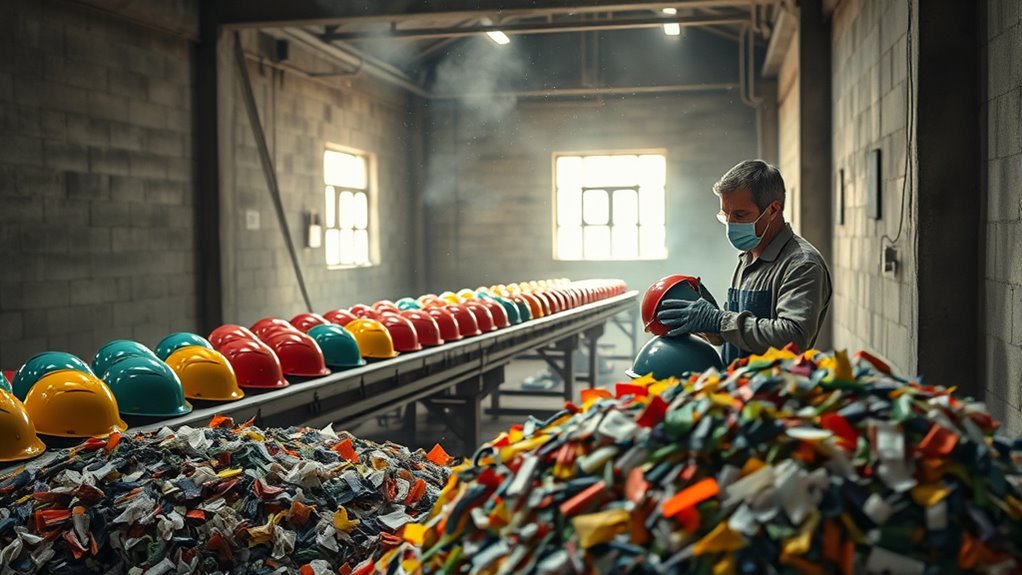The Environmental Impact of Helmet Production
Helmet production impacts the environment through raw material extraction, energy-intensive manufacturing, and waste generation. The extraction of minerals leads to habitat destruction, while manufacturing processes rely on fossil fuels, increasing carbon emissions. Transportation further amplifies the carbon footprint, especially with air shipping. Finally, significant waste from materials like polystyrene often ends up in landfills due to inadequate recycling methods. Understanding these issues reveals deeper insights into improving the sustainability of helmet production.
The Lifecycle of Helmet Production

Although helmets are essential for safety, their production involves a complex lifecycle that greatly impacts the environment. You might not realize that the materials used in helmets—such as polystyrene, polycarbonate, and fiberglass—are derived from processes that often harm ecosystems. Eco-friendly technologies are emerging, aiming to create more sustainable helmet materials. For instance, some manufacturers are exploring bioplastics and recycled materials, which can reduce carbon footprints greatly. These innovations not only help minimize waste but also support a shift toward circular economies. However, the adoption of such technologies is still limited, and you should consider these factors when choosing a helmet. By prioritizing eco-conscious products, you empower a more sustainable future while still ensuring personal safety.
Raw Material Extraction and Its Consequences

While the demand for helmets continues to rise, the extraction of raw materials necessary for their production poses significant environmental challenges. Mineral extraction often leads to habitat destruction, water pollution, and soil degradation. As you consider the implications, it’s essential to recognize the ecological consequences of these activities. Here’s a concise overview:
| Aspect | Impact | Long-term Consequence |
|---|---|---|
| Habitat Destruction | Loss of biodiversity | Ecosystem imbalance |
| Water Pollution | Contaminated water sources | Health risks for communities |
| Soil Degradation | Reduced agricultural yield | Food insecurity |
Understanding these factors helps you appreciate the broader implications of helmet production, urging a more responsible approach to resource utilization.
Manufacturing Processes and Energy Consumption

The environmental challenges associated with raw material extraction extend into the manufacturing processes involved in helmet production. You might not realize that energy efficiency during production can greatly impact overall sustainability. Many manufacturers rely on energy-intensive methods, leading to higher production emissions that contribute to climate change. For instance, the use of fossil fuels in heating and molding processes can escalate carbon footprints. By optimizing energy use and adopting renewable sources, companies can reduce emissions considerably. Emphasizing energy-efficient practices not only lowers environmental impact but can also enhance a brand’s image, appealing to consumers who value sustainability. Ultimately, addressing these manufacturing concerns is essential in aiming for a more eco-friendly future in helmet production.
Transportation and Distribution Impacts
As manufacturers produce helmets, the logistics of transportation and distribution play an essential role in determining their overall environmental impact. The choice of transport modes greatly affects the supply chain’s carbon footprint. For instance, shipping by air is faster but generates more emissions compared to rail or road transport. Understanding these dynamics is vital for minimizing environmental damage.
| Transport Mode | Carbon Emissions (kg CO2) per Ton-Mile | Efficiency Rating |
|---|---|---|
| Air | 0.50 | Low |
| Rail | 0.15 | High |
| Truck | 0.25 | Medium |
| Ship | 0.10 | Very High |
| Bicycle | 0.01 | Excellent |
Making informed choices in transport can enhance sustainability efforts.
Waste Generation and Recycling Challenges
Although helmet production is essential for safety, it also leads to significant waste generation and recycling challenges that manufacturers must address. The materials used, such as polystyrene and fiberglass, often end up in landfills, contributing to environmental degradation. Effective waste management practices are vital, yet many manufacturers lack thorough strategies for minimizing waste. Recycling technologies for these materials are still developing, making it difficult to reclaim resources efficiently. Without innovation in recycling processes, the environmental footprint of helmet production will remain problematic. As a consumer, you’re empowered to demand more sustainable practices from manufacturers, pushing for better waste management solutions and advancements in recycling technologies that could mitigate the ecological impact of helmet waste. Your voice matters in this pursuit of freedom from environmental harm.
The Role of Regulations and Standards
When regulations and standards are effectively implemented, they can profoundly influence the environmental impact of helmet production. A robust regulatory framework guarantees manufacturers adhere to safety standards while minimizing waste and resource consumption. By enforcing compliance, governments can drive innovation in materials and processes, leading to more sustainable practices. For instance, regulations that mandate the use of recyclable materials can considerably reduce landfill contributions. Additionally, safety standards should evolve to encourage eco-friendly designs without compromising protection. When you support these regulations, you not only enhance safety but also promote environmental responsibility within the industry. In this way, you can contribute to a market that values both personal safety and ecological sustainability, guaranteeing freedom from harmful environmental impacts.
Sustainable Alternatives in Helmet Design
While traditional helmet designs often rely on synthetic materials with significant environmental footprints, innovative approaches are emerging that prioritize sustainability without sacrificing safety. You might consider helmets made from biodegradable materials, which reduce waste and lessen environmental impact. Eco-friendly designs often utilize renewable resources, such as plant-based polymers, to create durable and safe products. Innovative technologies, like 3D printing, support the production of customized helmets with minimal waste, fostering a circular economy. As you evaluate these options, conducting an impact assessment can help determine the most sustainable choice for your needs. By opting for these alternatives, you can contribute to a greener future while ensuring your safety, embodying a lifestyle that values both freedom and responsibility.
Steps Towards Reducing Environmental Impact
To effectively reduce the environmental impact of helmet production, manufacturers can adopt a multifaceted approach that prioritizes sustainable practices throughout the lifecycle of the product. By incorporating eco-friendly materials, like recycled plastics and organic fibers, you can greatly lessen resource depletion and waste generation. Additionally, investing in innovative production technologies, such as 3D printing and energy-efficient processes, can minimize energy consumption and emissions. Implementing a circular economy model, where helmets are designed for disassembly and recycling, also plays a vital role in sustainability. By prioritizing these strategies, manufacturers not only fulfill consumer demands for environmentally conscious products but also contribute to a healthier planet, empowering individuals to make responsible choices without compromising safety or performance.
Frequently Asked Questions
What Materials Are Commonly Used in Helmet Production?
In helmet production, you’ll commonly find materials like polycarbonate, which is known for its durability and impact resistance. Additionally, various foam types, such as expanded polystyrene (EPS) and expanded polypropylene (EPP), are widely used for their energy-absorbing properties. These materials not only enhance safety but also contribute to lightweight designs, giving you comfort and freedom during use. Understanding these components can help you make informed choices about your helmet selection.
How Long Do Helmets Typically Last Before Disposal?
Helmets typically last about 3 to 5 years before disposal, depending on usage and care. Notably, studies show that nearly 80% of riders aren’t aware of their helmet’s lifespan. Proper disposal practices are essential; recycling is often overlooked. By understanding your helmet lifespan, you can guarantee safety while also being mindful of environmental impacts. So, check your gear regularly and consider replacing it to maintain both protection and sustainability.
Are There Eco-Friendly Certifications for Helmets?
Yes, there are eco-friendly certifications for helmets, focusing on eco certification standards that guarantee sustainable materials are used in production. Look for certifications like Cradle to Cradle or GreenGuard, which indicate that the helmet meets rigorous environmental criteria. These certifications not only promote the use of renewable resources but also minimize waste. By choosing certified helmets, you’re supporting sustainable practices and contributing to a healthier planet while enjoying your freedom on the road.
What Is the Carbon Footprint of a Typical Helmet?
A typical helmet’s carbon footprint can feel like a shadow, lurking in the background of its lifecycle. On average, production emissions for helmets range from 3 to 5 kilograms of CO2 equivalent per unit. This includes materials, manufacturing processes, and transportation. To truly grasp the impact, you must consider the entire lifecycle—from raw material extraction to disposal. Understanding these emissions can empower you to make more eco-conscious choices in your gear.
How Can Consumers Choose Environmentally Friendly Helmets?
To choose environmentally friendly helmets, you should look for sustainable brands that prioritize eco-friendly materials and ethical manufacturing practices. Research consumer awareness about these brands, reading reviews and certifications that highlight their commitment to sustainability. Consider helmets made from recycled or biodegradable materials, which can markedly reduce environmental impact. By making informed choices, you empower yourself and contribute to a healthier planet, ensuring your gear aligns with your values of freedom and responsibility.






